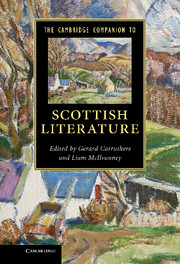Book contents
- Frontmatter
- Contents
- Notes on Contributors
- Acknowledgements
- Chronology
- Introduction
- 1 Scottish Literature before Scottish Literature
- 2 The Medieval Period
- 3 Reformation and Renaissance
- 4 The Aftermath of Union
- 5 Robert Burns
- 6 Enlightenment, Romanticism and the Scottish Canon
- 7 Scott and the Historical Novel
- 8 The Gaelic Tradition
- 9 Scottish Gothic
- 10 Victorian Scottish Literature
- 11 Robert Louis Stevenson
- 12 Hugh MacDiarmid and the Scottish Renaissance
- 13 Popular Fiction
- 14 Muriel Spark
- 15 The Glasgow Novel
- 16 ‘What is the language using us for?’
- 17 The Emergence of Scottish Studies
- 18 Otherworlds
- 19 Scottish Literature in Diaspora
- Index
- References
9 - Scottish Gothic
Published online by Cambridge University Press: 05 January 2013
- Frontmatter
- Contents
- Notes on Contributors
- Acknowledgements
- Chronology
- Introduction
- 1 Scottish Literature before Scottish Literature
- 2 The Medieval Period
- 3 Reformation and Renaissance
- 4 The Aftermath of Union
- 5 Robert Burns
- 6 Enlightenment, Romanticism and the Scottish Canon
- 7 Scott and the Historical Novel
- 8 The Gaelic Tradition
- 9 Scottish Gothic
- 10 Victorian Scottish Literature
- 11 Robert Louis Stevenson
- 12 Hugh MacDiarmid and the Scottish Renaissance
- 13 Popular Fiction
- 14 Muriel Spark
- 15 The Glasgow Novel
- 16 ‘What is the language using us for?’
- 17 The Emergence of Scottish Studies
- 18 Otherworlds
- 19 Scottish Literature in Diaspora
- Index
- References
Summary
So it was that Janet saw the male figure as it emerged from deep blackness into lesser blackness. The Moon had granted her wish, had brought her happiness. Crazed and joyful she careered down the stairs and flung herself passionately at the dark figure. There was a dreadful cry of outrage and disgust; she heard a voice hiss, ‘You filthy wee whore’, but she did not feel the knife as it stabbed again and again and again. Only a great langour seemed to draw her downwards, slowly falling as Orpheus cried out for her, falling towards the roar of the waters of Avernus.
Jim wiped his rabbit-skinning knife on his trouser leg. He had come in to turn off the music and the lights and so he turned them off. Then he went into the outer darkness. For a long time the castle was silent.
The wild winds of dawn beat about Auchnasaugh, moaning through the treetops and rattling the windowpanes. At last they retreated northwards, bearing with them Janet’s spirit, far north of love or grief, until their withdrawing was no more than the sigh of the sea in a shell.
This is the bleak conclusion to Elspeth Barker’s 1991 novel O Caledonia, but it can serve also as an oblique introduction to nineteenth-century Scottish Gothic. The shadowy, doom-laden figure; the shades of darkness and blackness; the sudden stab of violence, perhaps especially against women; the blank prosaism of the rabbit-skinning knife and the trouser leg when contrasted with the classical references in the previous sentence; the setting of the castle; the omnipresence of a fearsome and dominating natural world; the specific symbolisms of both ‘the north’ and ‘the sea’: all of these are features which we can find in the best-known writers of nineteenth-century Scottish Gothic, and in particular in works by Walter Scott, James Hogg, Margaret Oliphant and Robert Louis Stevenson, which will be my focus of attention in this chapter.
- Type
- Chapter
- Information
- The Cambridge Companion to Scottish Literature , pp. 132 - 144Publisher: Cambridge University PressPrint publication year: 2012
References
- 4
- Cited by

